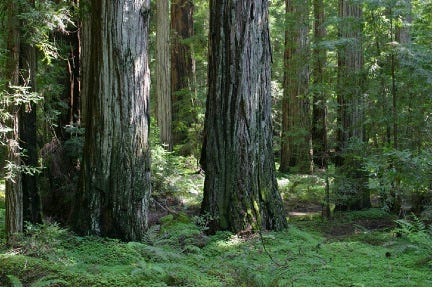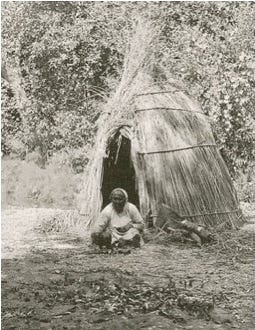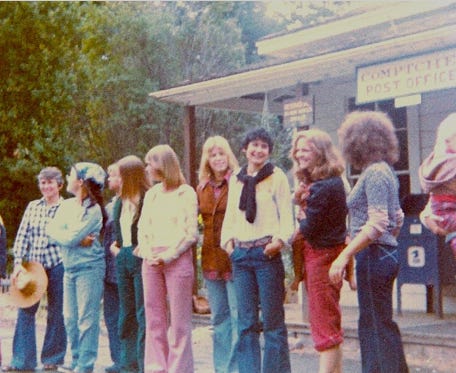The best and most detailed historical information about Comptche and Mendocino County has been consistently gathered and documented locally by people living there. Small-press and independent publications fill reference shelves of regional libraries, archives, and personal collections.
The region’s history continues to be well documented and photographed with great care by resident historians. The Kelley House Museum is an archive for the Mendocino Beacon newspaper, photographs, historical manuscripts, and other historical materials, as well as an historic landmark and museum in the village of Mendocino.
Local Comptche historian Elsa Thompson (1902-1986) researched, wrote and self-published Early Settlers of Comptche Along its Many Roads (1973). For this, she was well-known and respected by the community. For the Mendocino Beacon newspaper, she wrote a column Comptche and the Coast, sharing news about the small town 16 miles inland. Birth, marriage, death, who made the honor roll, 4-H achievements, prize winning quilts at the county fair. As an old-timer, Thompson wrote about what she heard at the Grange Hall, where newcomers (hippies) were denied membership. So our news was rarely represented because we were resented. I made her column a few times for good grades and 4-H ribbons, and each time she misspelled my surname.
Research in anthropology involves verifying facts and comparing sources, we’re looking for patterns. Reading and comparing Thompson’s Early Settlers of Comptche, I found patterns of errors when compared to other local, primary (original) sources.
This is important to note because journalism and non-fiction publications are ideally about fact and truth, these writers are also researchers. We are creating a public record that will outlive us. It is important to verify facts, dates, titles, and spelling—especially names.
Where Thompson shined is through her book, Early Settlers of Comptche. It’s based in oral history and lived experience. First-person accounts tell the story of the town’s first one hundred years and provides interrelated histories of pioneer families. A significant number of these old-timer families still work and live on their inherited land to this day.
Author Katy Tahja is Comptche’s current unofficial historian and librarian. She published All Roads Lead to Comptche (1999) to follow Elsa Thompson’s book about early settlers. Tahja excels in research, fact-checking, and continues writing many fascinating books about the regional history of Mendocino County.
The Pomo are the first people of Comptche and all three authors include the Pomo in their accounts of how the town was founded and grew. Ethel Docker’s autobiography The Good Old Days (1968) is the oral history of a forester’s daughter who grew up among the redwoods of Comptche the late 1800s. Ethel married into another local settler family, the Dockers. Her narrative reveals meanings of place names and paints a vivid picture of pioneer life when Comptche was sparsely populated and heavily forested. A time when the community’s current old-timers were the newcomers, and the Pomo were the ultimate old-timers.
Since the founding of Comptche in 1877, there has always been a volunteer resident historian who takes it upon herself to record the living stories of this place. Ethel Docker from the late 1800s to mid-1900s, then Elsa Thompson mid-century, and now Katy Tahja in the new millennium.
Independently published oral histories about life in Mendocino County are treasure troves. Among these personal stories, I found two recurring practices among immigrants of the late 1800s, the mid-1900s, and the 1970s: communes and food co-ops. This illustrates the trend of woodsmen immigrating to the region from Finland and forested northern Europe, where communes and co-ops are common. This was a successful way to colonize, living closing together to support one another and share resources.
During my year of field work, many times I drove over the low mountain range between Comptche and Ukiah. I had grown up taking this winding sometimes one-lane road that runs by Orrs Hot Springs and through the Montgomery Woods. This road was established by the Pomo, who walked in a day, after wintering in Ukiah, to camp in Comptche and then on to the coast on another day.
I drove to the Mendocino County Planning and Building Services office in Ukiah, where I met with Vale Whippert, Planner II GIS Cartographer. Whippet provided me with stacks of binders full of demographic data that had been gathered about Comptche during the 1960s and 1970s. The bulk of these records were U.S. Post Office reports filed by Postmaster, Aletta Hollister, who was also our 4-H leader.
I was specifically searching for population data prior to 1980—more recent demographics can be found on the Internet. Hollister’s reports give post office box counts. Since the only mail service for Comptche is at the post office, box-counts provide a good estimate of population and households.
I found what I was looking for among reports filed by the Comptche Area Citizens Advisory Committee (CAC). This committee met regularly during a county-wide zoning process from 1975 and 1978. Comptche was and is an unincorporated town and until 1978 had no general plan. Consequently, the CAC wrote the town’s very first general plan.
Whippert remembered the countywide planning meetings of the late Seventies. Fresh out of college, he had just begun working with the County.
“Those were lively meetings. People got emotional about land issues. Comptche was very organized,” Whippert recalled. “None of the other districts were prepared and organized like Comptche.”
During my year of field research in Comptche (2010-11), I found additional documents produced during the late Seventies by the Citizens Advisory Committee. Before writing the general plan, they created a community questionnaire, “Comptche Area Attitude Survey.” Katy Tahja provided me an an administrative copy with responses totaled resulting from 93 respondents. At that point in time, this represented 21 percent of the town’s population. The results of the 1977 survey match curiously with results of my questionnaire, written 33 years later for this project. The results of my 2011 survey are at the core of this study, and I’ll be sharing these findings in subsequent posts.
Comptche CAC Chairman Michael Nolan provided me with a copy of their final report and recommendations, filed with the County in June of 1978: Comptche Conservation Plan, prepared by Comptche General Plan Citizen Advisory Committee and Mendocino County Planning Division. However, this is not merely Comptche’s general plan; it is a unique and fascinating record of the remarkable process between old-timers and newcomers. The report details how they found common ground and created a shared vision for managing growth.
The Comptche Conservation Plan provides an honest and thorough assessment of a town by its residents. It is the result of participatory decision-making. This was intended to be a living document, keeping current with desires and intentions of its population through periodic review by a meeting among residents. Relationships are written into this community process.
Relationships and cooperation among new and long-time residents are the way the residents built a bridge to common ground. Numerous studies of rural communities and common ground agree that collaboration, cooperation, relationships, and building community capacity are imperatives for building healthy communities.
Resources for this post and for further reading:
Barrett, Samuel, 1908. The Ethno-Geography of the Pomo and Neighboring Indians
Baumgardner, Frank, 2006. Killing for Land in Early California
Citizens Advisory Committee, 1978. Comptche Conservation Plan
Docker, Ethel, 1968. The Good Old Days
Kelley House Museum: Native American Inhabitants of Mendocino County
Tahja, Katy, 2006. All Roads Lead to Comptche
Thompson, Elsa E., 1973. Early Settlers of Comptche Along its Many Roads
Levene, Bruce and Sally Miklose, 1976. Mendocino County Remembered: An Oral History, Vol. 1
Levene, Bruce, 1989. Fort Bragg Remembered: A Centennial Oral History
Yoneda, Sylvia, 1988. From Sointula to the Redwood Strike: Cooperative Traditions Among the Coastal Finns









